Located on the Pacific Ring of Fire, Taiwan is a showcase of both nature’s beauty and its terrible power. The island nation’s volatile plate tectonics make it prone to natural disasters. Yet, these same forces have created the majestic mountain landscapes of many Taiwan nature attractions — earning it the name Formosa, which means “beautiful isle” in Portuguese.
Apart from its mountains, Taiwan boasts a wide range of natural habitats, most of which are protected within its national parks. Read on to discover the best places to enjoy nature in Taiwan!
Also read: This Traveller Shares Her Cycling Journey Along Taiwan’s Coastal Highways
National parks in Taiwan for adventure seekers
1. Taroko National Park
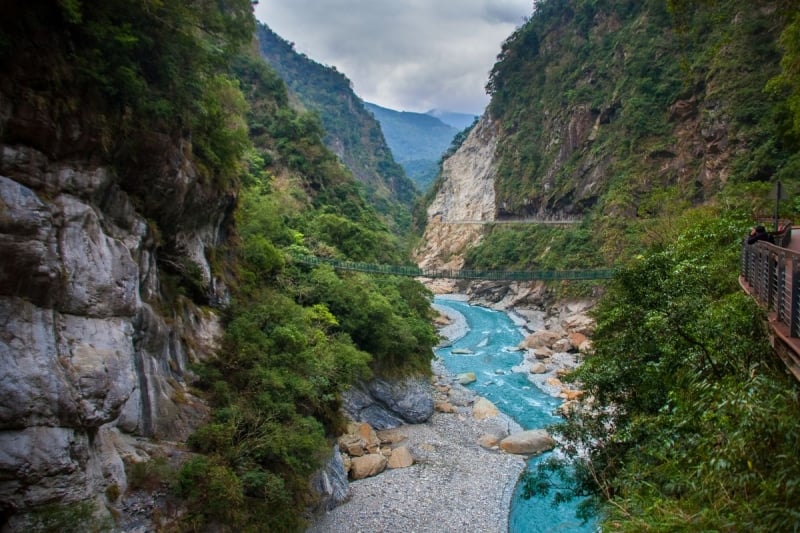
Image credit: kitchakron via Canva Pro
Carved into marble by the mighty Liwu River, Taroko Gorge is an awesome display of nature’s power. Located in Taroko National Park, this narrow gorge has steep sides that rise to dizzying heights, enclosing a thin sliver of sky. Despite the risk of landslides and rock falls, the park attracts visitors with its mesmerising beauty.
In some parts of the park, there are signs advising visitors to don a helmet as falling rocks are a frequent occurrence. This serves as a reminder of mankind’s fragility in the face of the dramatic forces that have shaped this spectacular area.
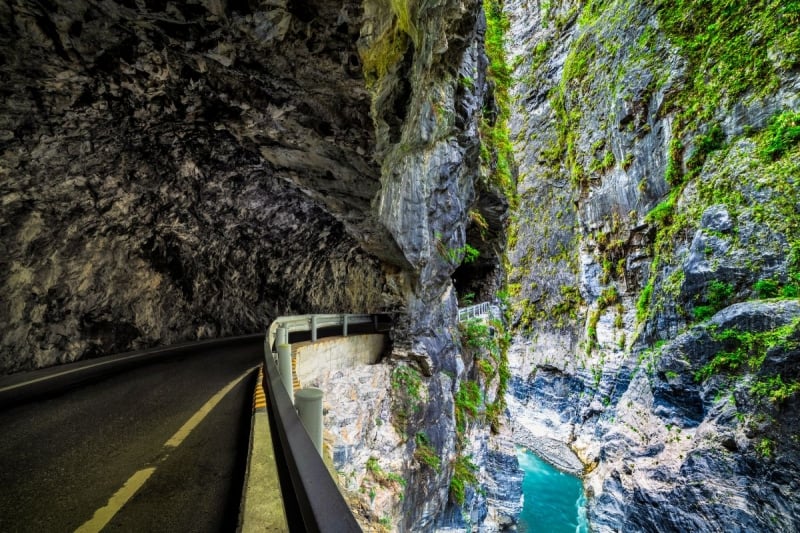
Yanzikou | Image credit: GoranQ via Canva Pro
Yanzikou
Apart from its famous gorge, Taroko National Park holds plenty of otherworldly sights. Inside Yanzikou or the Swallow Grotto, you can find marble cliffs pockmarked with small holes due to erosion from groundwater and the Liwu River. These holes serve as nesting sites for swallows that dart in and out, gathering food for their young.
Changchun Shrine
Close to the east entrance of the park, visitors can find the surreal Changchun Shrine (Eternal Spring Shrine). It derives its name from the Changchun Falls it stands on, which never stops running. As the falls plunge into the Liwu River, they appear to cascade from the shrine itself, forming a sensational sight. This Tang Dynasty-style complex was built to honour the 212 workers who died during the construction of the Central Cross-Island Highway.
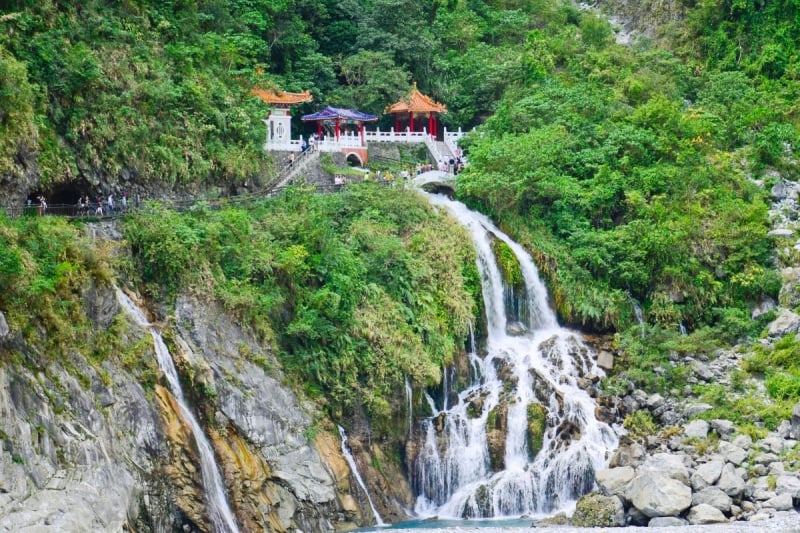
Changchun Shrine | Image credit: Assawin via Canva Pro
To get to the shrine, you’ll have to conquer the Changchun Trail, a steep path cut into the mountainside. The trail won’t be a walk in the park, but it’s well worth the effort. Along the way, you’ll get to stop at a number of historic sites including the Taroko Tower, “Stairway to Heaven” suspension bridge, and Changuang Temple.
Also read: 15 Reasons Why Japan Lovers Will Also Love Taiwan!
2. Shei-pa National Park
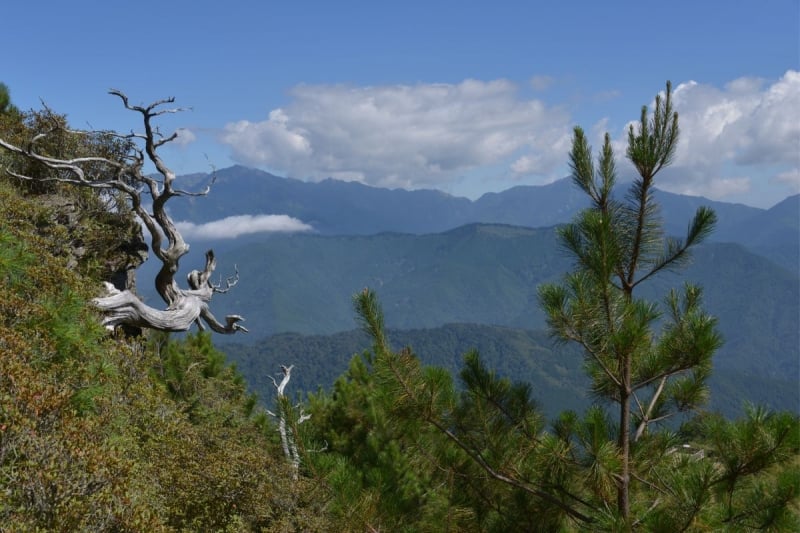
Image credit: TopPhotoImages via Canva Pro
Does it ever snow in Taiwan? Well, it does on the peak of Mount Xueshan (Snow Mountain), the tallest of Shei-pa National Park’s 104 mountains, and the second tallest in Taiwan. On the peak of Mt. Xueshan is Cuei Pond, the highest alpine lake in the country. Another name for this tiny lake is the Angel’s Tear because of its teardrop shape.
Adventure seekers should attempt the East Xue Trail, which will take them on a gruelling climb up the infamous Crying Slope. Those who persevere will reach the mountain’s east peak, where one can admire the sea of clouds rolling rapidly over the Shei-pa Mountain Range.
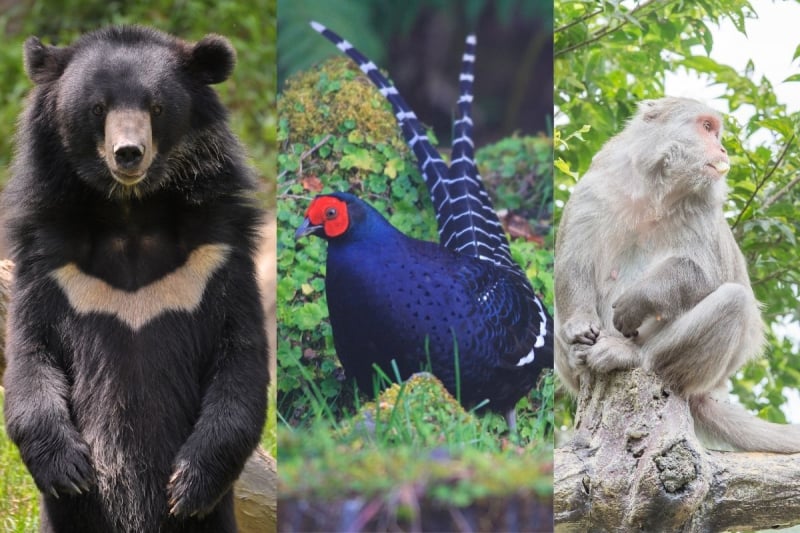
Image credit (L-R): Picas Joe, feathercollector, and insjoy via Canva Pro
Nature lovers should keep a look out for the rare species found in Shei-pa National Park. The park is a sanctuary for 26 endemic species, including the Formosan macaque, the Mikado pheasant, and the Formosan black bear.
Safety tip: The Formosan Black Bear is a rare but not impossible sight in the park. Should you encounter one, back away slowly and refrain from making sudden movements.
National parks in Taiwan for hiking junkies
3. Yangmingshan National Park

Image credit: You Ren Chen via Canva Pro
If you don’t want to venture far from Taipei, this is the one national park in Taiwan you must visit. Yangmingshan National Park is a nature park centred around Mount Qixing (Seven Star Mountain), the highest dormant volcano in Taiwan. Rising 1,120m above sea level, its last eruption was 700,000 years ago. Since then, its crater has split into seven small peaks due to erosion — hence the name.
Yangminshan is among the best national parks in Taiwan to visit from February to early March. Here, you can catch a glimpse of the mountain blanketed with cherry blossoms. The Yangmingshan Flower Festival is held every spring and offers a gorgeous display of cherry blossoms, azaleas, camellias, and more!
Hiking trails in Yangmingshan National Park
There are three different trailheads where you can start your hike up Mount Qixing The first is Miaopu Trail: popular among tourists for its proximity to the Yangmingshan Bus Terminal. While it may be the easiest to get to, it is longer and lacks the scenic views of the other trails. The Lengshuikeng (Cold Water Valley) Trail starts from the parking lot and, despite its name, is riddled with hot springs and simmering fumaroles. Fumaroles are vents that emit steam and volcanic gases, sort of like the spout of a boiling teapot.
Along the trail, you can take a detour to Menghuan Lake (Dream Lake), home to a rare species of fern called the Taiwan quillwort. To protect the fern, tourists are not allowed to go to the shoreline of the lake. However, they can still admire Menghuan Lake from a small sightseeing deck. Watch as a thick blanket of mist settles on the lake, turning it into an enchanting dreamscape.
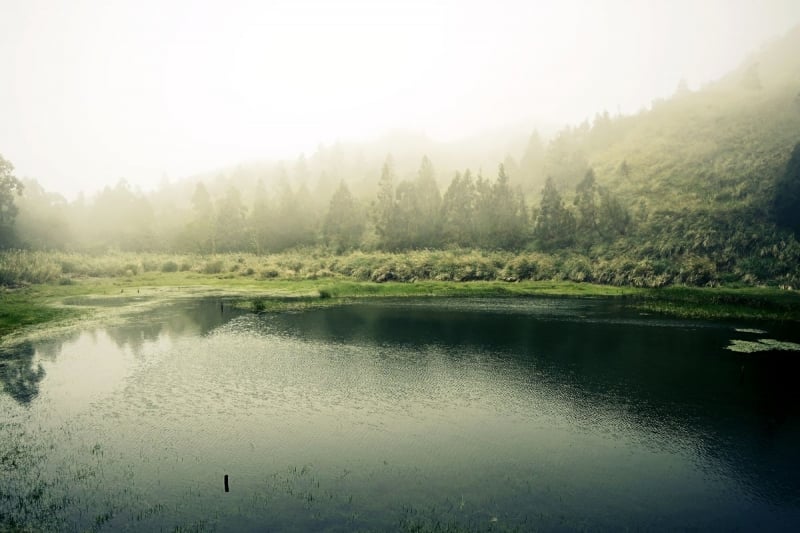
Menghuan Lake | Image credit: Liu Han Lin via Canva Pro
The last trail starts from the Xiaoyoukeng bus stop. Although this is the shortest trail, it offers close-up views of the park’s geothermal wonders. You’ll find steaming volcanic pools right next to the footpath, but resist the urge to dip your toes in them. Unless you want to ruin your vacation with an awful burn, that is. When you reach the trail’s viewing platform, you’ll be rewarded with phenomenal views of the surrounding volcanic cones of Mount Zhuzi, Mount Datun, Mount Qixing, and Mount Xiaoguanyin.
4. Yushan National Park
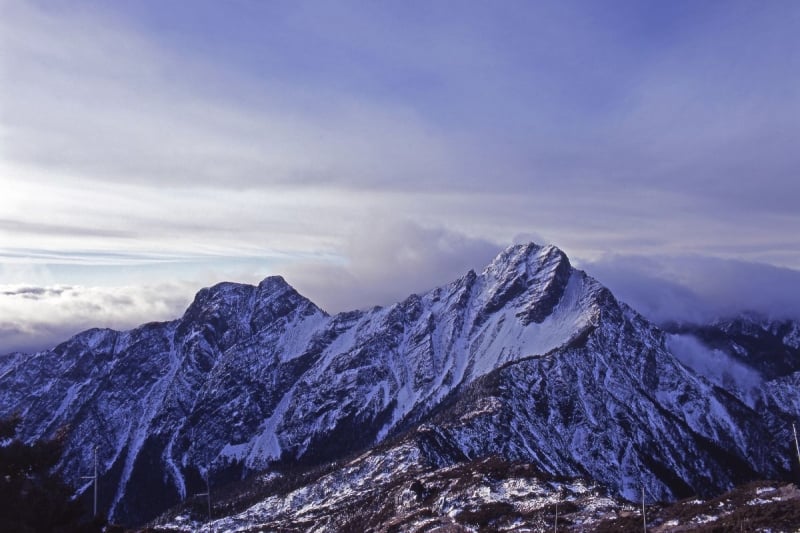
Image credit: TopPhotoImages via Canva Pro
Yushan (Jade Mountain) is Taiwan’s tallest mountain, standing at a height of 3,952m above sea level. The name comes from the mountain’s snowy appearance in winter, which resembles pure white jade. Hikers will find no shortage of trails to choose from; the national park covers 3% of Taiwan’s land area, making it the island’s largest.
While Yushan may be the main draw of the national park, the park holds plenty of other natural attractions worth a hike. Xiuguluan Mountain is the tallest in Taiwan’s Central Mountain Range, and is covered in pale green juniper shrubs, giving it an ethereal feel.
The Yunlong Waterfall (Cloud Dragon Waterfall) is a 70m-high cascade that tumbles down a V-shaped valley. You can reach this magnificent sight by taking a leisurely 4km walk from Dongbu Hot Springs Trailhead.
Also read: Winter in Taiwan: 14 Best Things to See, Do, and Experience
National parks in Taiwan rich in culture
5. Shoushan National Nature Park
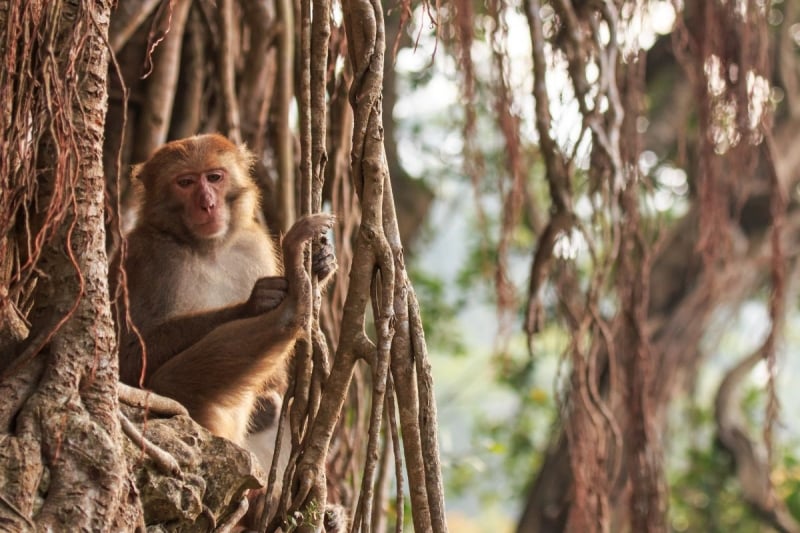
Formosan rock macaque at Shoushan | Image credit: outcast85 via Canva Pro
Shoushan (Monkey Mountain) is named after its plentiful Formosan rock macaques, which are endemic to Taiwan. The national park surrounding the mountain is a historic treasure, holding 4,000-year-old ruins and military installations from the Qing dynasty. Among its attractions is Qihou Fort, which was built during the reign of the Kangxi Emperor to defend Kaohsiung Harbour. During the first Sino-Japanese War, fire from Japanese warships partially destroyed the sign atop the fort.

Former British Consulate at Takao | Image credit: fotorav via Canva Pro
On the peak of Shoushan, you may rest your feet at the Yazuo Pavilion and take in a magnificent view of the Taiwan Strait. Free tea is also provided here by kind volunteers who regularly carry 20kg water containers up the mountain.
After climbing Shoushan, there’s still plenty to explore. At the top of the nearby Shaochuantou mountain is the former British Consulate at Takao. Takao was the old name of Kaohsiung, and an indigenous word for a type of bamboo found in the area. Today, the Baroque-style consulate building is a cafe offering panoramic views of Kaohsiung Harbour.
6. Kinmen National Park
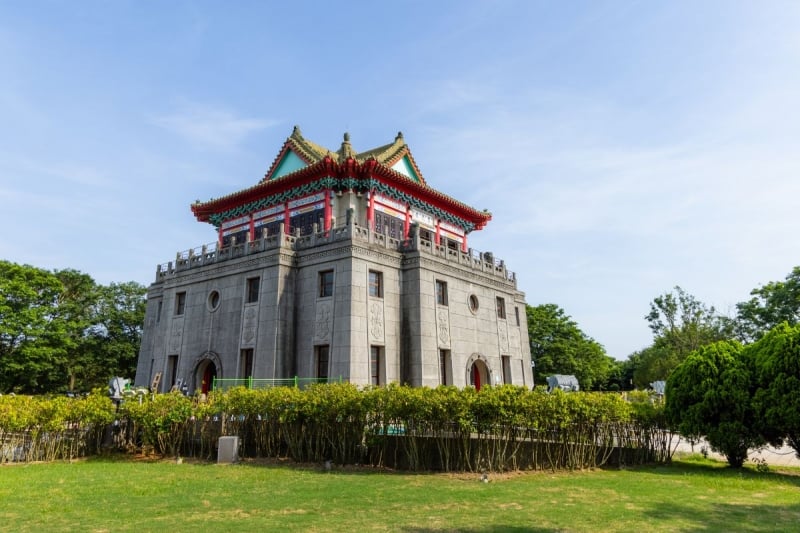
Juguang Tower | Image credit: Leung Cho Pan via Canva Pro
Off the west coast of the main island, Kinmen National Park straddles two islands: Greater Kinmen and Leiyu. Due to its proximity to Mainland China, Kinmen has been the site of many fierce standoffs between Taiwan and China. The islands’ iconic Juguang Tower was built in 1953 to commemorate the fallen soldiers at the Battle of Guningtou. Two cannons front the tower, reminding visitors of the island’s troubled past.
Visitors curious about the battle memorialised by Juguang Tower can stop by the Guningtou Battle Museum. The museum exhibits military weapons, equipment, and photos from this critical moment in Taiwanese history. Tanks used in the battle are displayed outside the museum, providing a great photo opportunity.
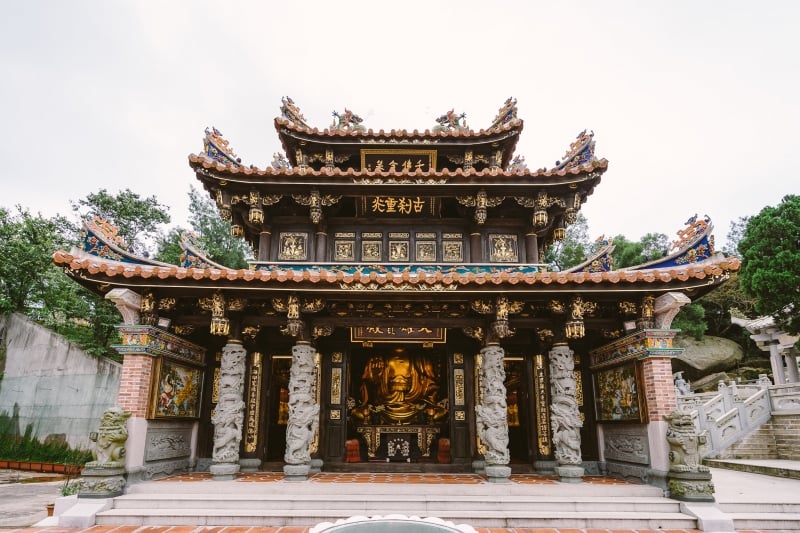
Haiin Temple on Taiwu Mountain | Image credit: Wei-Te Wong
The highlight of the park is Taiwu Mountain, the highest peak in Kinmen. The trails on the mountain were used by food traders in the old days, and as such, have been named the Tofu Ancient Trail. While hiking up Taiwu, travellers can stop at historic sites such as the 800-year-old Haiin Temple and the Daoying Pagoda.
Coastal national parks in Taiwan
7. Taijiang National Park
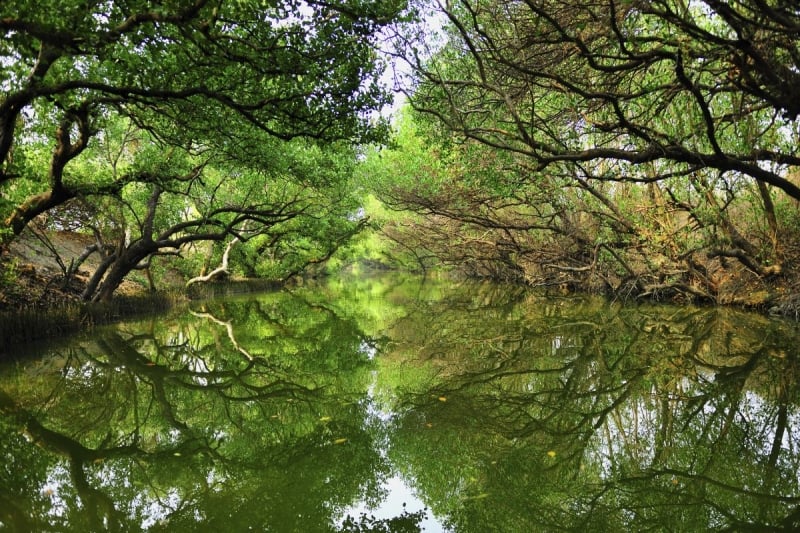
Image credit: TopPhotoImages via Canva Pro
Taijiang National Park is a tranquil sanctuary on Taiwan’s southwest coast for rare species of birds, fish, and crustaceans. Straddling the land and sea, the park encompasses unspoiled mangroves, lagoons, and wetlands.
To catch a glimpse of the park’s impressive biodiversity, pack your binoculars and head to the Qigu Wetlands. These wetlands are home to several endangered species, including the black-faced spoonbill, oriental stork, and peregrine falcon.
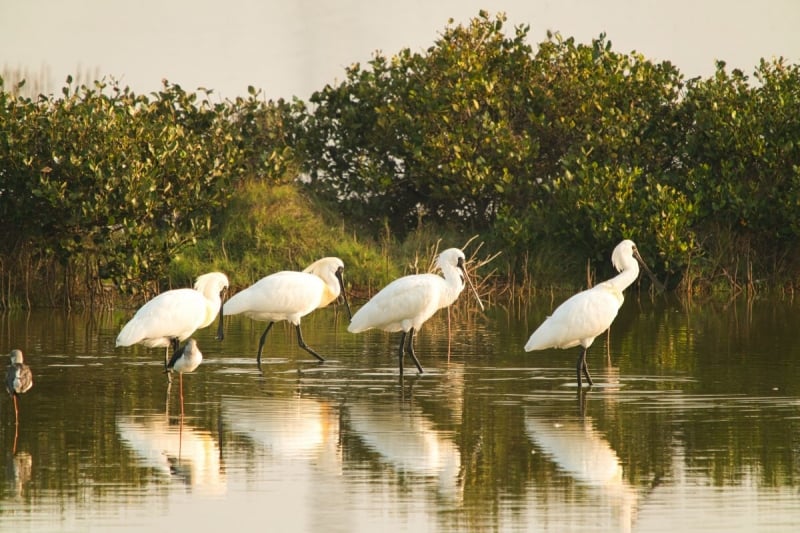
Black-faced spoonbills | Image credit: Chao Feng-Lin via Canva Pro
There are only around 6,000 black-faced spoonbills left in the entire world. Two-thirds of them spend winter in the warm south of Taiwan, making the Qigu Wetlands a vital conservation area. These elusive birds were nearly driven to extinction in the 1980s, but have made a comeback due to bird-friendly aquaculture practices. By rearing milkfish in shallow ponds, fish farmers allow the spoonbill to feed on the remaining small fish and crustaceans after the harvest season.
8. South Penghu Marine National Park
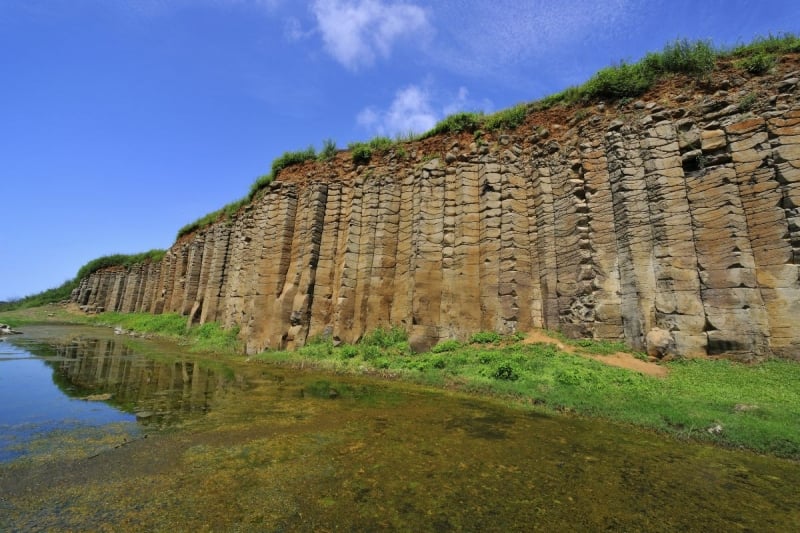
Image credit: TopPhotoImages via Canva Pro
Tired of hiking up mountains? Come to South Penghu Marine National Park, where you can dive into an underwater paradise. Covering a number of idyllic islets between Wangan and Chimei, the park holds 154 species of corals and 254 species of fish.
Glorious basalt sea stacks rise out of the park’s glittering waters, making for a jaw-dropping sight. On the Xijiyu islet, tall basalt columns have perfectly aligned to form an 800m-long cliff.
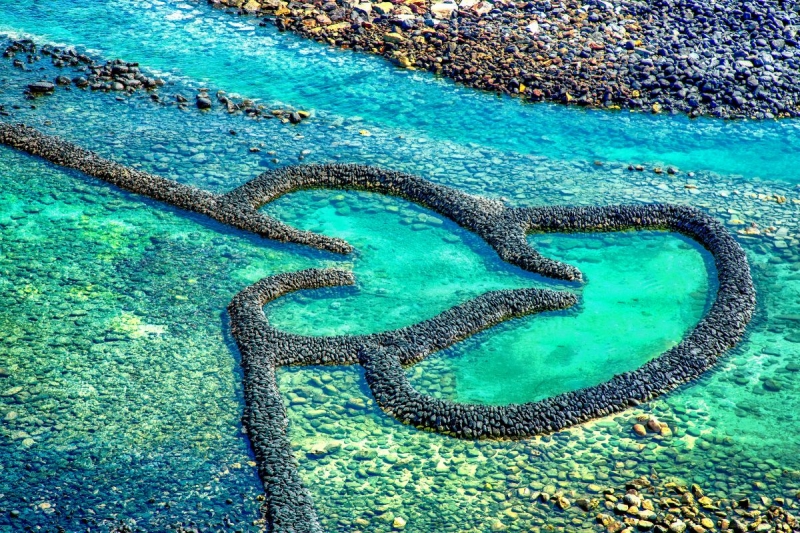
Twin Hearts Stone Weir | Image credit: GoranQ via Canva Pro
From Chimei island, you may take a bus to see the famous Twin Hearts Stone Weir. This romantic rock wall resembles two hearts stacked on top of each other. The weir is not a natural formation but rather, a traditional fishing trap. During high tide, fish swim into the weir, which traps them inside when the tide recedes.
Also read: Goodbye EasyCard? Taiwan Transforms Its Transport Pass to Sailor Moon Sticks!
9. Dongsha Atoll National Park
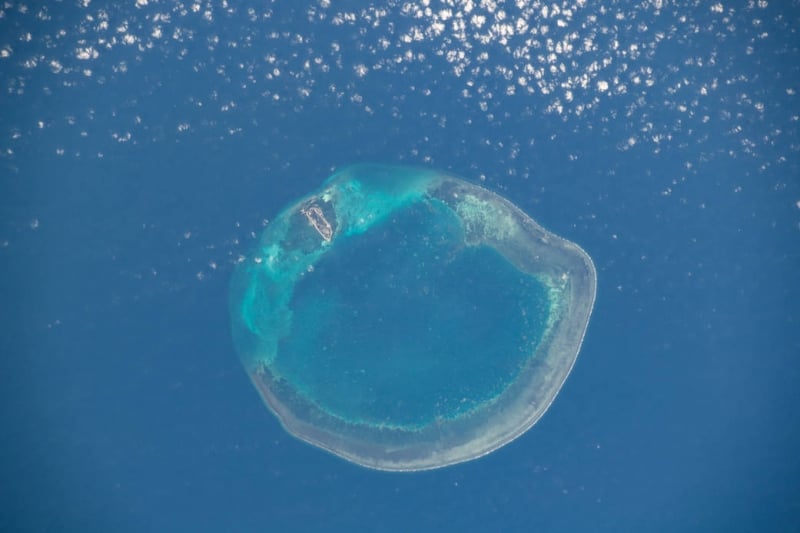
Image credit: NASA Official Website
The Dongsha Atoll National Park is currently closed to visitors due to ecological studies and restoration in progress. Comprising Dongsha Island (also known as Pratas Island) and its surrounding lagoon, the park is a refuge for numerous species of fish, jellyfish, corals, and squid. It also lies along the migration route of many birds in East Asia, serving as a “stepping-stone” on their flight across the ocean. The shallow waters around Dongsha Island are covered in seagrass beds, which provide food and shelter for marine creatures.
Note: Experts are currently studying the feasibility of ecotourism in the park. Whether or not the park will later be opened to visitors has not been confirmed.
10. Kenting National Park
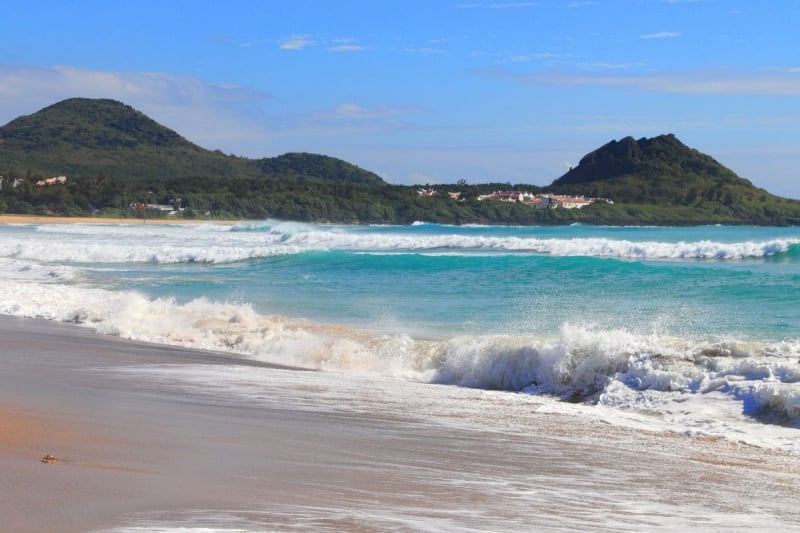
Image credit: Mlenny via Canva Pro
Located in the country’s balmy south, Kenting National Park is the perfect tropical escape among all the national parks in Taiwan. Its white sand beaches and shimmering bays make for a serene day trip from the bustling city of Kaohsiung. Head to Xiaowan (Little Bay Beach) to take a dip in its calm waters that are shielded by a natural barrier. Jet-skiing, snorkelling, and banana boat rides are also popular activities here.

Eluanbi Lighthouse | Image credit: stevencyc via Canva Pro
In Nanwan (South Bay), you will find the famous Eluanbi Lighthouse, which stands on Cape Eluanbi, the southernmost tip of Taiwan. Built during the Qing Dynasty to protect ships from attacks by indigenous peoples, Eluanbi is the only fortified lighthouse in Taiwan. US bombing in World War II damaged the lighthouse but the Republic of China later restored it and opened it up to visitors. Today, it is a popular tourist attraction for the panoramic views it offers of Kenting’s rugged coastline.
Just a 20-minute drive from Kenting National Park is the Kenting National Forest Recreation Area. Here, you can find the 400-year-old Looking Glass Tree, which looks straight from a fairy tale with its moss-covered buttress roots. Thousands of years ago, this forest was under the sea and covered in coral reefs. The movement of tectonic plates transformed the forest into a distinctive ecosystem filled with uplifted coral, limestone caves, and canyons.
Other Taiwan nature attractions worth visiting
11. Alishan Scenic Area
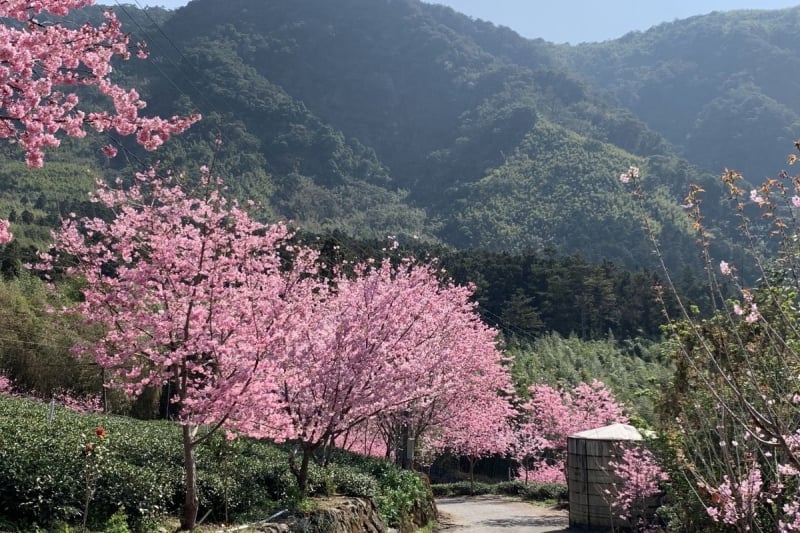
Cherry blossoms at Alishan | Image credit: Yi Ting Pan via Canva Pro
Famed for its oolong tea and cherry blossoms, Alishan Scenic Area is the crown jewel of Taiwan nature attractions. From Chiayi, you can board the vintage Alishan Forest Railway, which will take you on a leisurely ride as it slowly winds around the mountain. If you arrive in early spring, a curtain of pastel pink cherry blossoms will be there to greet you.
Of course, no visit to Alishan is complete without trying a cup of Alishan high-mountain tea. Described as “the champagne of tea”, this oolong tea is something special. Grown at altitudes of over 1000m, Alishan high-mountain tea matures slowly in a cold, misty environment. This slow growing process gives the tea the complex flavours that tea connoisseurs praise it for.
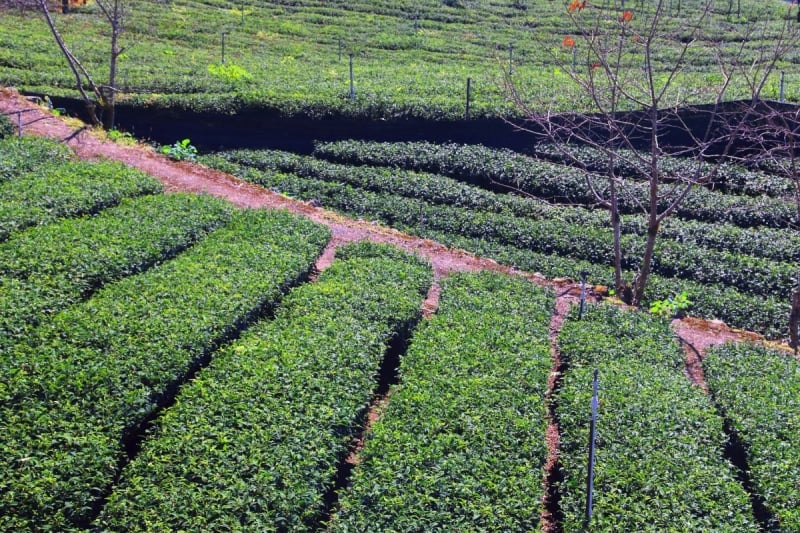
Shizuo tea plantation near Alishan | Image credit: tupungato via Canva Pro
However, most Alishan tea farms are not within the Alishan Scenic Area itself. On the way here, stop by Shizuo, a sleepy town known for its numerous tea plantations. While sauntering around the tranquil fields, enjoy the stunning view of Alishan at sunrise, shrouded by a dreamy blanket of mist.
12. Taipingshan National Forest Recreation Area
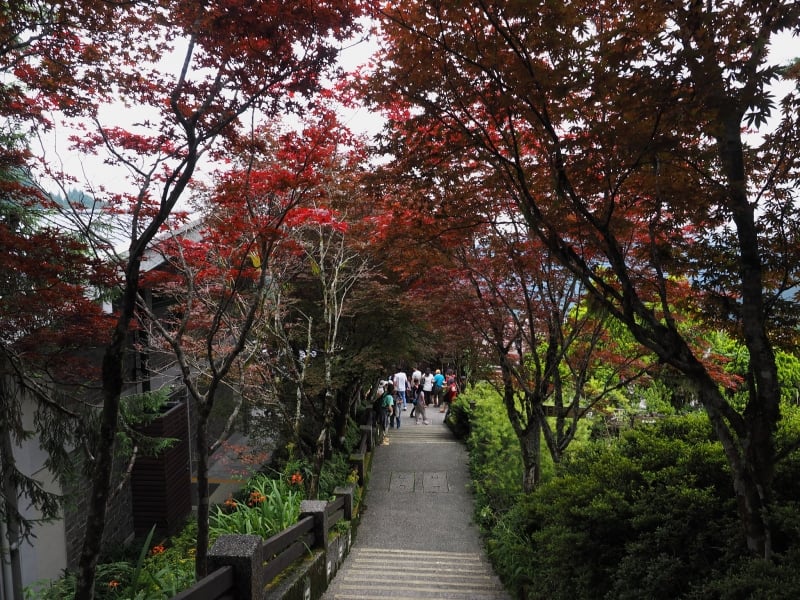
Image credit: pang yu liu
Located in Yilan County, Taipingshan is a must-visit destination if you’re visiting Taiwan in autumn. The mountain is notable for its purple-leaf maple trees, which sport a deep violet canopy in early autumn before turning flame red.
Besides, Taipingshan has several hikes known for their arresting beauty. The Taiwan Beech Trail is populated with the rare Taiwan beech, a tree dating back to the Ice Age. The leaves of these trees turn from green to golden yellow as winter approaches, adding to the forest’s riotous autumn palette. You can also hike to Cueifong Lake, the largest alpine lake in Taiwan, or take a peek into the area’s logging past along the Jancing Historic Trail.
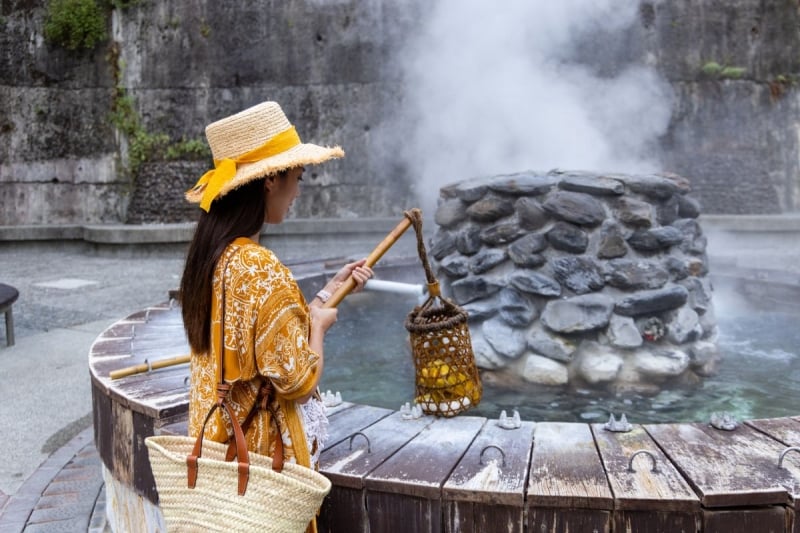
Jiuzhizhe Hot Springs | Image credit: Leung Cho Pan via Canva Pro
After a long hike, rest your feet and soak in the Jiuzhizhe Hot Springs. Originally built by Japanese loggers, the spa allows visitors to cook their own hot spring eggs. A dip in bubbling spring water and a breakfast of freshly cooked eggs. Is there any better antidote to your worries?
Things to remember when visiting these Taiwan nature attractions
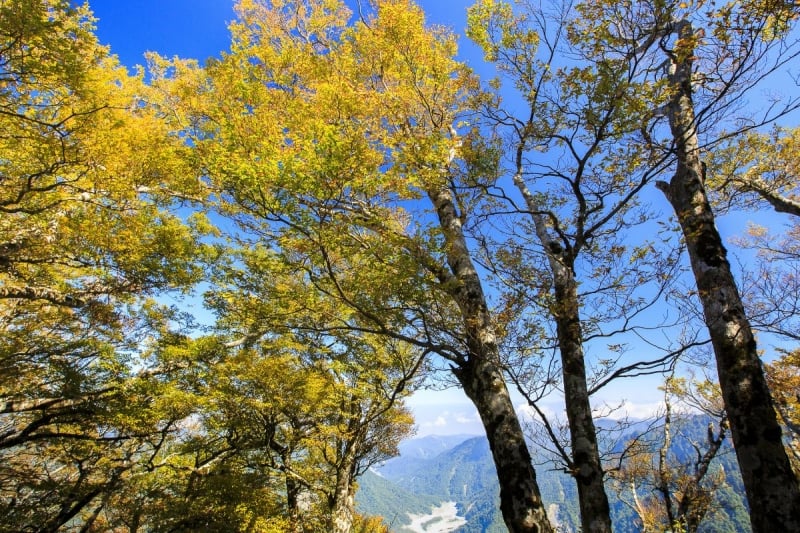
Autumn in Taipingshan National Forest Recreation Area | Image credit: TopPhotoImages via Canva Pro
1. Permits
Shei-pa, Taroko, and Yushan National Park require a permit for hiking. Camping inside the park requires a special permit as well, so make sure to apply for all the necessary permits before your visit. The park authorities allot permits based on a lottery system, so apply early and cross your fingers.
2. Etiquette
Do not remove rocks, corals, mud, or fossils from the parks. In general, take nothing but photographs and leave nothing but footprints.
3. Wild animals
Refrain from feeding the macaques inside the parks. Avoid carrying food inside the park as the macaques may attack people to snatch their food.
Also read: Confessions of a City Dweller: I Travel to See Nature & Here’s Where I’ve Gone
Whether you’re longing for a relaxing retreat or a chance to push yourself to your limit, these national parks in Taiwan have something to offer. Don’t miss out on these natural gems on your next Taiwan trip!
Featured image credit: leochen66 via Canva Pro




